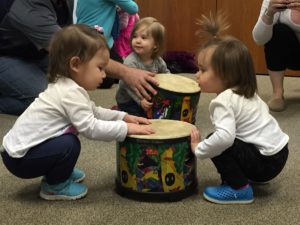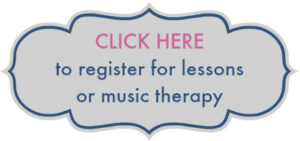
This past Sunday, Music Therapy Connections hosted an open house, and it was a blast! We invited the Springfield community to step through our doors, meet our music therapists and teachers, and spend time making music together.
Seeing new faces and familiar faces connect with each other and explore our facility was such a thrill, especially with everyone being from all different walks of life.
One of my favorite moments during the open house was when we invited everyone into our big room for some group drumming. From little infants to teens, parents of young children to older adults, we shared the time exploring our creativity, playing together, and best of all, enjoying music.
I would love to share with you how we structured our drum circle to incorporate a wide range of ages, needs, and comfortability level.
Drum Circle Age considerations:
- For our little ones, we used low floor drums and encouraged caregivers to sit on the floor so they would have a greater range of movement to support, hold, model, and do hand-over-hand movements with their young children.
- For young children who didn’t need the motor guidance of a caregiver, we encouraged participation and empowered their independence by giving them choices (i.e., Big drum or small drum? Floor drum or hand drum? Mallets or no mallets?).
- For our children, teens, and adults, we encouraged creativity by asking for options of how to play (i.e., Asking participants to come up with hand motions, asking participants whether they want to play fast or slow, etc.).
Comfortability Level Considerations:
- This might be the first time a lot of participants have ever played an instrument, let alone a drum! Encouraging choices for all participants is big. You should structure songs to include a variety of different styles, motions, volumes. Once everyone has a better idea of different options, structure the song to include parts where people can explore their creative side without feeling insecure or exposed.
- How can you do this? Have half the group tap a basic beat while the other half freely improvises and then have the two sides switch.
- Include songs that are have chants, sequenced portions, or repetition so that participants have a predictable structure to follow. Once everyone is comfortable with the familiar section, gradually add new components.
- I like to have a cycle of familiar/predictable sections, new sections, and then a return to familiar/predictable sections.
- Don’t forget to validate! A simple “I hear you!” or “Wow, I like your energy!” can go a long way in encouraging new players throughout.
- Drumming can be loud. Model as much as you can! Sometimes over explaining can overcomplicate things, and a lot of times, people can’t hear you over their own drumming. Try minimizing verbal explanation and instead, replace it with concise and direct language, or eliminate verbal directions all together and use your drum, exaggerated facial expressions, and exaggerated body language to motivate everyone to have greater focus and jump right in.
I hope you found these drum circle considerations helpful! If you’d like to share some drumming ideas with us, or ways you’ve adapted drumming experiences for individuals of all ages, we’d love to hear from you in the comments below!
And if you’d like to learn more ideas about how to incorporate drumming into your sessions, check out Kalani Music. For songs and chants that can be adapted for all ages, check out Ella Jenkins! These have been great resources and inspirations to me as I keep growing as a music therapist. Best of luck in your journey!





Hi
I love that you are getting people in Springfield involved with drumming.
My friend Arthur Hull has produced a great video on facilitating drum circles that you may like. Here is link to the video. I was lucky enough to be able to drum in one of the circles in the video.
Here is the link:
https://villagemusiccircles.com/the-art-of-drum-circle-facilitation/
I also saw that you were referring people to Kalani’s site. I know Kalani and have taken some workshops and drum circles with him. He is a nice guy. Here is a video from a workshop on drumming with special needs populations that I attended that Kalani taught a few years ago. About 3/4 of the way through he invited people up to play the instruments and I went up. I am the person that Kalani has play a short bell solo with some kid’s bell set.
https://m.youtube.com/watch?v=w4W2IC8W5EI
Once again I love that you are getting people in Springfield involved with drumming.